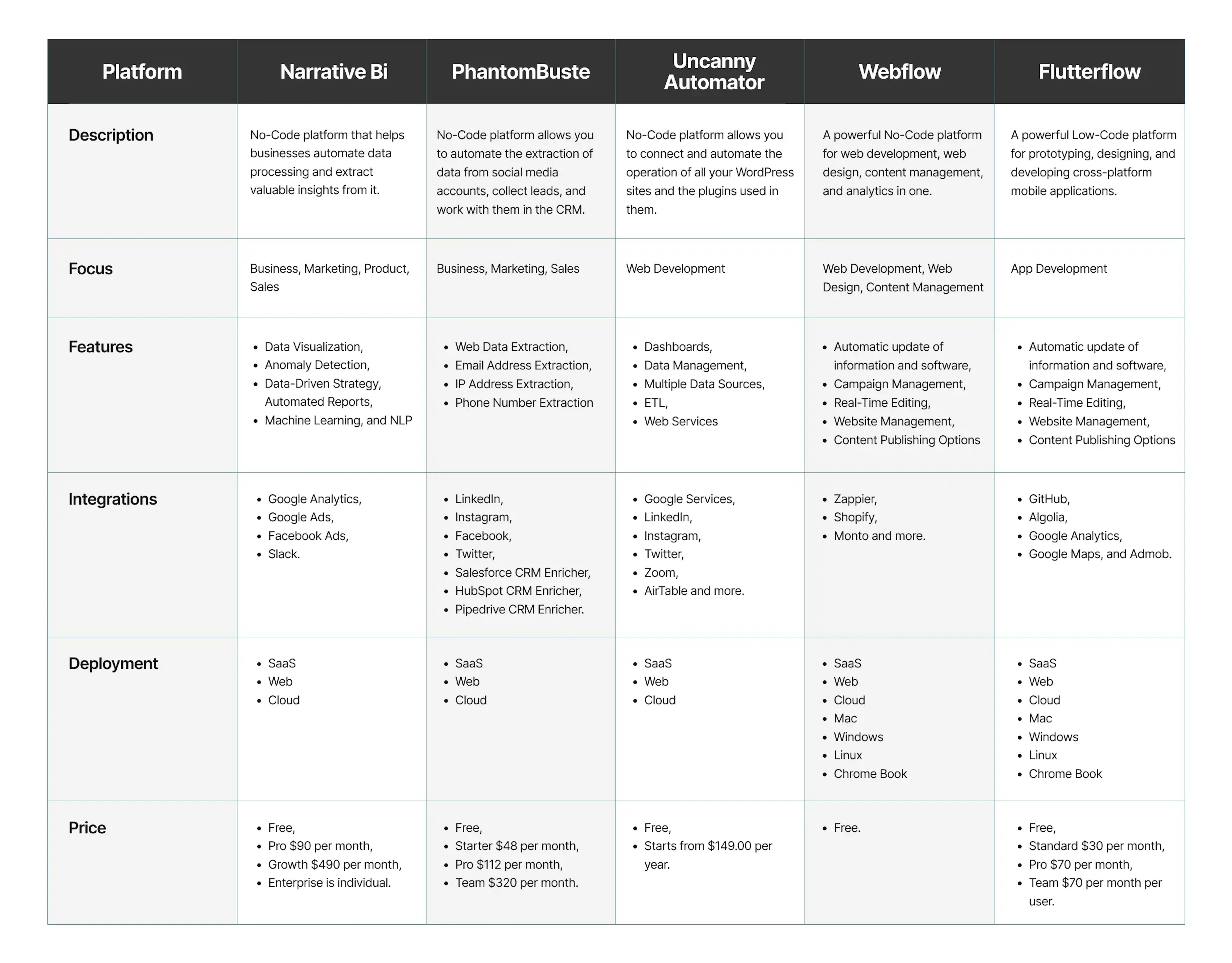The no-code and low-code development market is booming. Some people, including specialists, believe that no-code and low-code are the future of the development industry. Others insist that when it comes to customization, coding is needed.
The truth is in the middle, as usual. While no-code/low-code development is a way to speed up time-to-market and simplify the development process, they aren’t a panacea. Here, we delve into the matter to check whether no-code and low-code can replace the actual development and, if yes, to what extent it can be done.
Low-code and no-code techniques are a great way to simplify the development process. They have been available for around a decade. Now though, they are growing in popularity. The reason behind the popularity growth is evident: businesses want to reduce costs on the development of, say, a new feature or new functionality. Demand creates its own supply. Therefore, no-code and low-code platforms such as QuickBase and Jotform Apps are booming.
Both low-code and no-code platforms provide the means to build a website or an app without or with minimum coding. They take a visual approach to app development. It makes the website and app development accessible to tech-savvy individuals who might not know any programming language.
What is no-code?
Of course, software development does not begin with the code. First, the development team takes a large business task and decomposes it into many smaller technical tasks and subtasks. By decomposing the task, the developer refines the requirements to make sure that the decomposed task still meets the business goals and plans. Once the requirements are refined, the developer designs a solution architecture, taking into account all the technical details. And only after this architecture is approved as fast, flexible, stable, and secure enough - does the developer or team of developers begin to write the code.
The answers may start to vary if you ask where in all this no-code. Some will say that no-code strives to do all the previous steps and doesn't even allow you to do them yourself. Others will say that no-code strives to spare us only writing code and tries to provide an ever-increasing variety of options for simply creating more complex solutions.
The truth is that a good no-code solution requires you to do all the previous steps as much as is necessary and possible, except for writing code. Instead, no-code provides a set of software modules and a graphical representation of them that you can use to quickly build a simple website, application, or other solution your business immediately needs.
The No-Code approach is suitable for companies that initially have no technical expertise or do not need complex technical solutions. Also, the no-code approach is suitable for businesses if they want to visualize their ideas and test their market hypotheses before investing time and money in proper development.
What is low-code?
As the ancients said, virtue is the middle ground. Similarly, low-code strives to save us from having to write code manually, especially in the case of typical code already written millions of times. Still, it also greatly enhances our ability to write it manually when needed.
Low-code provides a set of programming modules, often also represented graphically, which you can use relatively easily and quickly to build a not-so-complex but large solution. Furthermore, you have much more power over the solution's architecture since the code of many of these modules can be significantly modified or extended by other modules and third-party integrations.
How do low-code and no-code work?
As computers have evolved, we are constantly adding layers of abstraction so that the user can use technology more and more easily. Maybe someone here still remembers how we used to even navigate through folders in the system using commands in the terminal, but now just by clicking on a folder icon. It's the same not only for the user but also for the programmer, where many things are done for them or even without them.
At first, a lot was taken over by compilers that translate program code into machine code. For example, the C and C++ compilers allow you to write low-level code without learning the machine instructions of each CPU. Then we saw that programming languages began to have functionally ready libraries, and even the languages themselves began to have more ready-made features. For example, Python, therefore, became a standard in many industries. Now we see IDEs offering not only automatic syntax highlighting and code suggestions but even the ability to integrate tools to generate code. Just look at the excellent products from Intellij Idea and maybe controversial, but definitely noisy Copilot.
However, such tools leave many fundamental decisions to the programmer, starting from the system architecture, writing specific features, etc. So there is a big difference between improving programming tools to make them easier for programmers and making programming itself easier for non-programmers.
In no-code and low-code, we see another level of abstraction, a graphical level for the programming itself. In essence, we are given ready-made blocks that perform specific tasks and are compatible with each other in advance. They are all represented graphically, and for you, it looks as if you are just moving graphical function blocks. Although inside each one, there is a block of code that performs the corresponding function. By selecting and combining them, you are actually combining two code bases whose mutual work is prescribed in each other's code.
Difference between low-code and no-code
The specific difference between no-code and low-code is obviously expressed in the number of limitations and the range of capabilities we discussed about earlier. Here we have highlighted the main ones.
| NO-CODE | LOW-CODE |
|---|---|
| If you use a No-Code platform with its drag-and-drop functionality, you can build a basic app only. It will not scale properly. The integration opportunities will also be very limited. And the customization possibility is limited to non-existent. It, in turn, leaves gaps for security and compliance issues. | Low-Code platforms (such as WordPress) take an intermediary position between No-Code solutions and fully-fledged development. They abstract low-level development and automate manual processes. |
| Architectural considerations also arise commonly. No-Code platforms are mostly used by those who don’t know how to code. So, we guess these people have no experience in the application of architectural patterns. And it, in turn, means that the app architecture will be monolithic. | Low-Code platforms can also be visual-based. They also can use drag and drop functionality. But they give developers more flexibility by also allowing manual coding and scripting. |
| The majority of No-Code platforms require deployment to their public clouds. It means that if you use their No-Code solutions, you won’t be able to deploy them in your cloud. | Low-Code solutions are distinguished by a higher level of scalability and flexibility. Developers can exercise control over the solution quality by testing it and running QA procedures. Such solutions have the potential of being developed into more sophisticated products. |
| Such solutions do not support third-party integrations and cannot connect to legacy systems. | Many Low-Code platforms come with comprehensive component libraries and support third-parties smart services offered in the cloud. Low-Code platforms allow the development of many products, including complex ones. |
No-code and low-code can do a lot but not everything
While low-code seems to be an optimal solution, do not hurry to switch to it and apply Low-Code platforms for every product you are working on. Low-code also comes with some limitations. Since most of our customers need large, complex, and unique solutions, their requirements often go beyond such limitations. And this is where Mad Devs can provide the deepest expertise and highest value to each client. That's why we've formed a particular approach to using no-code and low-code solutions.
No-code Mad Devs approach
First we go in Discovery stage, where we conduct deep business and technical audits to most accurately identify the problem and to find the best solution.
By the way, to learn how important all development stages are, from Discovery to Maintenance, we highly recommend our book Approach to the Software Development Process. We detailed all the processes and shared the best proven approaches to building and maintaining them, making them the most flexible, transparent, and efficient. Take advantage. You're always welcome.
So if the solution is so simple that it can be solved with No-Code, all of our years of expertise in developing large and complex solutions is simply redundant. Working on such a project will not extend our expertise, and the client will overpay. Since our principle is to bring true value and provide only the highest quality and most profitable solutions, we do not work with such cases as:
- Landing pages;
- Online business cards;
- Checkout pages;
- Personal pages;
- Project portfolio or a resume, and similar cases.
We can give the client some tips on how to do it and even send links to the platforms that, in our opinion, might be the best for their specific case.
Low-code Mad Devs approach
Since Low-Code imposes fewer limitations and offers more possibilities, we can rarely use it as some steps or as some part in the development of a more complex solution. Even so, for the reasons mentioned above, we don't make Low-Code the basis for such solutions:
- Authorization pages and pages/websites with similar functionality;
- Training platforms;
- E-commerce (online shops, sales of services);
- Small forums;
- Mini-blogs and similar.
Of course, in addition to an in-depth business and technical audit of the company and the project, you can always contact us for a free consultation. We will study your idea in detail and advise the most profitable solution. And also we have developed a quick guide that helps to determine whether Low-Code can be used to the full extent or weather manual coding is needed.
Customization
You can use a Low-Code solution if you don’t need a highly customized solution. You are fine with just filling in a database and adjusting styles, colors, etc. In such a case, a Low-Code platform will provide you with all that you need.
However, if you count on a high customization level, be ready to pay. The more precise your requirements are, the higher is the customization level.
Say you need to build a mobile app for tracking public transportation movement. But to synchronize the geolocation in a database, you would need to create a custom mini-service which shall be developed manually. Or you can construct a taxi service, but for unique custom solutions, you will need to code manually. So, No-Code and Low-Code approaches work in some cases and only then, when no high customization level is needed. While they definitely help to reduce time-to-market but they aren’t suitable for the development of entire complex enterprise solutions.
Consider it in advance and plan the budget accordingly.
Digital Accessibility
Digital accessibility requirements are another challenge to those who prefer Low-Code. Digital accessibility requirements are difficult to implement in a website based on a template. To use a Low-Code platform for developing a website with digital accessibility requirements, you need to:
- Create a prototype (with Low-Code)
- Run the accessibility tests
- Bring the Low-Code prototype to the company’s standards.
It might be difficult, if not impossible. And making your content available to as many people as possible might be the foundation of your business.
If a company has digital accessibility requirements, using a Low-Code solution might not be the best option.
The Depth of Code
Now, think about what you want your solution to do. Say you need to develop a page flow that is based on inputs. The inputs are calculated, and depending on the result, a user is moved to a respective page. For example, a user fills in an electronic form to get a loan. If the user’s income is too low, the app shall redirect the user to a rejection page. You can hardly implement this functionality with No-Code or Low-Code resources only. It will need some coding.
Security
While No-Code and Low-Code platforms offer already available components, these components still contain code. And this code was not developed by your team. Moreover, you might have no idea by whom the components were developed. They were developed by somebody who delivers the code via pre-configured modules. It means that you rely on outsourced solutions. Additionally, when you need to update your workflow, you also outsource it.
No-Code and Low-Code platforms are developed to enable faster development. It doesn’t necessarily mean that the components might fail to undergo proper testing and security checks. But you shall agree that such a possibility is higher than if the app is developed properly.
Data validation might also be an issue. The majority of No-Code and Low-Code platforms allow the manipulation of data easily, but they mostly do not have proper means to secure data. And it might be a significant issue if a website or an app manipulates sensitive business data.
While all security risks cannot be eliminated completely, they can be mitigated. However, it means additional measures. And it, in turn, slows down the development process. In the very end, it is safer to hire a team of developers.
What can you develop with no-code and low-code?
If you approach no-code and low-code in a smart way, you can use them to optimize the development of many solutions. The most typical examples are the following.
Business processes automation
Here, the simplest example is the customer journey and the automation of this process. For example, when a customer writes a message on Facebook, what does the solution have to do? It has to send the message to the CRM system and send a Slack notification to the staff. In a similar way, you can build agent and broker portals, self-service policy administration apps, customer portals, and similar. While there are many options to choose from, we recommend using Zapier because it handles all these solutions perfectly.
Simple websites and mobile apps
The opportunities are extensive here. For example, Editor X helps us to create data-driven sites and complex web apps. It offers integrated business solutions, add custom code and use a powerful CMS. Or platforms like Bravo allow you to construct a mobile app directly from Figma. If you have an app already, you can add databases, authorization functionality, push notifications, etc. So, with Bravo platforms alike, you can shorten the gap between a prototype and an actual application. But wait, we will show the top of platforms in each category below. Let get the main point first.
Benefits of low-code and no-code platforms
- Firstly, they drastically lower the barrier to entry for non-technical people who want to create their software applications. It is a great opportunity for someone who wants a great idea for a website or app but needs at least minimal demonstration to attract investment.
- Secondly, it allows for much faster prototyping and iteration thanks to its visual nature. So this is a great opportunity for small and medium-sized businesses to quickly and cheaply test their hypotheses before full-scale development of new products and entry into new markets.
- And lastly, it saves businesses a lot of money in development costs since they won't need to hire as many coders or outsource development companies. It can be a great opportunity for a business that needs a large but not highly complex solution that can take a minimum to launch and maintain.
The need for low-code and no-code
This is one of those cases where there is simply no room for debate. The need for low-code and no-code is becoming increasingly obvious to businesses, and demand for it is growing very actively. It is enough to look at the figures given by various research publications, which differ only in how much the market for low-code and no-code solutions will be valued and how large-scale the implementation of low-code and no-code in companies will be.
Statista expects the global market forecast for Low-Code is around 65 Billion U.S. by 2027. GlobeNewswire looks further ahead and sees $187.0 billion by 2030, with a 31.1% CAGR. That sounds very promising.
One might reasonably ask, where is this big growth coming from? But it doesn't seem surprising if you believe Appian, who states that 82% of companies can't attract or retain the developers they need. Here their data is almost identical to Gartner, who states that 80% of companies will have policies in place for citizen developers by 2024. They also claim that 70% of new applications will use low-code or no-code platforms by 2025, compared to 25% in 2020.
However, make no mistake that low-code and no-code will take over all markets. As we said, the enterprise segment is always too big, too complex, and too unique, requiring far more out-of-the-box solutions and diverse integrations to be implemented, so low-code and no-code can not handle it. They need a fundamentally different level of flexibility, stability, and security that low-code and no-code have yet to achieve.
We at Mad Devs are not afraid, we love, and we are strong in building large and complex systems from scratch, meeting the highest standards, and bringing the highest value to the business. Although we closely follow the development of technologies, actively participate in their development, integrate the best that the market can offer, and offer the market only the best from us.
For example, our development Enji easily integrating which you can customize and automate common operation of the communication platforms like Slack, task management platforms like Jira and code repositories like GitHub and GitLab. Enji collects and process data from all of them, giving you complete overview of the each team, project and internal company operations just in few clicks.
What is low-code and no-code AI?
It is obvious that AI/ML is a game changer in the technology world. With the proper approach, it improves the performance of any previous solutions and allows us to turn collected data sets into invaluable treasures. However, AI/ML is not the easiest technology, requiring specific specialists in a special set of knowledge and skills in addition to the programming itself. Despite the complete reasonability, developing and implementing such technologies for any company can take away a significant part of the budget and can be completely unaffordable for some. This is where low-code and no-code AI comes to the rescue.
Low-code and no-code AI are low-code and no-code platforms, which simplify the development, deployment, and maintenance of AI/ML-based applications. They provide a set of ready-to-use software solutions, part of which is AI/ML for various types of data collection and processing.
Of course, here we come again to the fact that such a solution is suitable for relatively simple tasks that AI/ML performs. If you need to process huge amounts of complex data or initially complex tasks like advanced computer vision for atypical tasks, then you will have to approach this more fundamentally. However, if you need a typical personalized recommendation feed on your website, low-code and no-code AI can be your magic wand.
What are the best no-code and low-code platforms?
No-code and low-code platforms are where you directly build your website, application, and so on, gaining access to a ready-made code base with a set of ready-made, graphically designed code blocks. All of these platforms focus on different tasks and use different ways to solve them, accordingly giving you different capabilities and imposing different limitations. To make it easier for you to get acquainted with them, we have divided the top ones by their main purpose and indicated their main capabilities and features.

Bottom line
We admit that no-code and low-code can reduce the time to production and cut development costs significantly. However, both approaches have to be used smartly. And, of course, they cannot completely replace development in its traditional sense.










